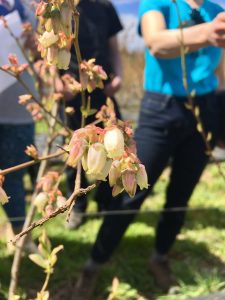
Pollinators: One of the goals of our project was to increase pollinator populations because they facilitate the growth of blueberries and are key to plant reproduction and health. Pollinator surveys were conducted to determine the type and quantity of pollinators visiting the blueberry fields at WWR.These surveys helped monitor our progress toward reaching our goal of increasing pollinator populations at WWR. Two surveys were taken over an eight-week period during mid to late bloom. Each survey was conducted on the same four 60-meter transects of blueberry rows used by past ELP teams. Groups of two consisting of a pollinator surveyor and data recorder walked down the transect at a pace of three meters per minute. The surveyor identified and counted pollinators that were visiting the stigma end of the flowers, and the data recorder wrote down the information. This data was compared to data from previous years to determine the change in pollinators over the years.
Results: There was an increase in the number of honey bees in 2018. This is most likely due to the 48 honey bee hives that were placed adjacent to the blueberry fields by Whitewater Ranch to ensure pollination of the blueberry plants. There was a lower n umber of flies and bumble bees in 2018 than previous years. The higher abundance of flies and bumble bees in 2015 could be due to a colder winter before the 2015 survey was taken. Both flies and bumble bees tend to do better in colder winters than honey bees, which would result in the higher abundance in the 2015 survey. The decrease in bumble bees over the years after 2015 could also be a result of competition with the honey bees. The lower overall number of pollinators in 2016 and 2017 could be a result of data collection errors, or variability in the weather. It is recommended that next year’s ELP team should work to increase bumble bee habitat as an effort to increase their populations.
umber of flies and bumble bees in 2018 than previous years. The higher abundance of flies and bumble bees in 2015 could be due to a colder winter before the 2015 survey was taken. Both flies and bumble bees tend to do better in colder winters than honey bees, which would result in the higher abundance in the 2015 survey. The decrease in bumble bees over the years after 2015 could also be a result of competition with the honey bees. The lower overall number of pollinators in 2016 and 2017 could be a result of data collection errors, or variability in the weather. It is recommended that next year’s ELP team should work to increase bumble bee habitat as an effort to increase their populations.
To return to Our Efforts, click here.